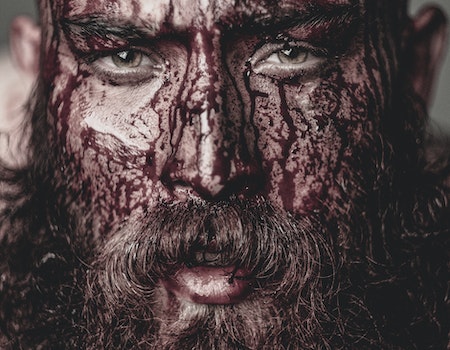Male Viking War Paint
Stories similar to this that you might like too.
Vikings had elaborate war paint, a mixture of colors and materials that varied from one culture to another. It was designed to help the warrior see better in low-light conditions or at night. The brighter it was, the more useful it could be as protection against enemies who would have trouble seeing you if your face was painted up like a rainbow.
There are accounts of women also using war paint for similar purposes—to hide their identities when they entered foreign lands. This is why the term “war paint” came into use; it’s no longer an indicator of sex but of status among Vikings.
War paint consisted of reds, yellows, whites, black, and white. White made the eyes look larger, and yellow made them look smaller. Red made people think you were angry (and thus easier to kill). Yellow meant you were brave or stupid and white meant you didn’t care about being killed.
And black made your skin appear darker. So while it may not be clear how this would make the wearer harder to identify in dark conditions, that’s exactly what happened. Some artists painted their faces so brightly with black and white that the Norsemen began using a black pigment mixed with charcoal to make their own war paint—making it much lighter and less noticeable.
Most importantly though, there was always the possibility of getting caught by someone who knew how to peel off paint without leaving any traces. If you did manage to get away, the paint would wash off during the next day’s bath. A good war painter was skilled enough to remove paint even after weeks of traveling under the sun’s glare.
In addition to the paints used to paint themselves, there were also painted that covered shields and weapons. The shield was usually painted white or silver to reflect light, giving the wielder an advantage over other warriors in combat.
Weapons, too, were often painted. Most often they were painted with symbols indicating the owner’s skill or prowess in battle. These included images of skulls, crosses, axes, or sometimes a dragon. One famous warrior, Sigurd Snake-in-the-Eye, had his weapon decorated with the symbol of a wolf.
His enemy assumed that Sigurd must be very proud or arrogant because he was so well equipped; however, the image actually referred to the mythological animal Fenrir, which he intended to use in the coming battle. The idea is that if you fought Fenrir, you’d be lucky to survive.
As the years passed and we learn more about these legendary figures, we will surely find ways to explain many of the stories as exaggerations, myths, or propaganda put forth by the victorious forces. Still, it’s hard to deny the importance these men held in people’s lives, even thousands of years later. They shaped history itself and left behind tales that continue to capture our imaginations today.
***
The Viking Way of Warfare
One of the things that make Vikings so interesting is that they weren’t just one kind of fighter. As with many cultures before them, it was important for them to know all the different ways to defeat their opponent. In order to do that, you needed an understanding of all sorts of fighting styles. That meant learning from people who were experts at hand-to-hand combat, archery or throwing knives.
There were five major types of Viking weapons: the sword, axe, spear, mace, and bow.
Sword: A long sword, it was generally two meters in length with a curved blade and cross guard, though there are reports that indicate some swords were shorter. This weapon was most often used in duels or when fighting close to the enemy since the blade was short enough for you to wield it effectively.
Axe: An axe was much bigger than a sword and had a wide head designed to split logs. The blades of axes were often curved and serrated to cut through wood or hide with ease. Axes were used in both war and peacetime because they were so effective in clearing land. They were also considered great equalizers as anyone could learn how to use them, regardless of age or strength.
Spear: Spearheads were made of bone or horn, while shafts were either metal or made of wood. Spears were used by foot soldiers, archers, and horse archers. They were also used to fight bears and wolves in case they ran amok and attacked you.
Mace: Maces were basically like giant hammers, only with spikes instead of a head. They were primarily used as blunt instruments to break bones and smash shields.
Bow: Bows were the standard ranged weapon of the Norsemen. Their arrows were shot by attaching the bowstring to a leather thong around the neck or chest. Because bows could shoot farther than spears, they were more popular with archers, but they were also used by horse archers (those who used horses rather than their own legs to draw the bow) to defend themselves against charging enemies.
Though the Vikings relied heavily on their weapons, they didn’t rely on one style exclusively. Instead, they took advantage of each one in different situations, depending upon the situation. The best example of this was the way they fought battles. It seems that many times the Vikings won through trickery and deceit.
When they went to war, it was never to take a country, city, or farm. When you hear people talk about “taking” lands, they really mean taking a place that no longer belongs to anyone in particular and using it for yourself until your enemies return.
For the Vikings, it was much simpler: They wanted to take everything. So if they saw an opportunity to steal, they took it. And that included food stores, livestock, tools, weapons, jewelry, and any other possessions that could be sold and converted into coins for the warriors’ families back home.
But they never destroyed their enemies, even if they found themselves outmatched and defeated in battle.
If you were a warrior in the service of King Hakon of Norway or Denmark, chances are he sent you to attack another king or chieftain whose territory overlapped yours. There would have been several reasons for this, including the desire to expand his territory or gain wealth and power.
Whatever the reason, it was common for them to fight over the spoils and treasure of the defeated leader. Sometimes it was a matter of greed, but it was also about prestige – whoever owned the most booty, won.
This system led to a lot of brawls, but those were not the real battles. Battles were fought on open land in the woods, fields, and pastures where it was more difficult to control the terrain and where the enemy was less likely to have an advantage. These were known as sieges, and in many cases, they were decided with little or no bloodshed.
So it was up to the victors to make sure they were victorious. One of the most effective ways to win a siege was to lure the defenders away from the main fortress and into an enclosed space like a tower or walled town, which offered fewer places to hide and fewer places for them to run.
Then the attackers poured boiling pitch, oil, or fire down the good shafts of these buildings in order to burn or kill everyone inside. This was how they conquered Paris and other large cities along the River Seine. It was a bloody business, but it worked.
Another strategy the Vikings used was to send in raiding parties to harass towns and villages, burning crops and homes and stealing livestock before retreating quickly. If the raiders did it right, it would force the locals to call a local lord or king to demand protection and justice. That’s when the Vikings came in and slaughtered everyone and burned everything before withdrawing again.
Finally, you sometimes heard stories about the Vikings attacking a castle at night. The idea behind this was that if they got in during the dark, the inhabitants of the fortification would be disoriented by the darkness and wouldn’t realize their fate until too late.
In some cases, they were able to capture the castle and hold it hostage until they received payment from their victim. In others, they ransacked all of the valuables within and then left, taking as much booty as possible with them.
But in most cases, the Vikings simply took what they wanted and killed everyone who stood in their way. They had no interest in negotiating; they weren’t interested in saving their enemies and allies – they were just looking for loot.
***
The Vikings had a reputation as fearless warriors and masters of tactics, but there was another side to their history that you may not know about. It is said that the Norsemen preferred to drink than fight. They spent far more time in taverns than they did on battlefields and even drank wine with dinner, unlike their enemies who mostly abstained from alcohol.
In addition to drinking ale and mead, they also enjoyed fermented milk drinks called “kvass,” which were popular in parts of Europe long before beer became commonplace. And while the English thought of the Vikings as wild barbarians, their cuisine was far more varied and sophisticated than the stereotypes suggest.
The Viking women cooked meals similar to what we know today and served them alongside beer and ale instead of water or tea. They made bread, butter, and cheese, and they ate meat such as beef, mutton, and horseflesh.
There was also a certain charm to their food, as some of the dishes they prepared have become staples in kitchens around the world today – like boiled fish, pickled herring, and oat porridge.
As for the Vikings’ penchant for pillaging, rape, and plundering, I’m afraid it is true. They did it because it was easy, and it was also a good way to get rid of unwanted wives. Most of those they captured and raped were already married or betrothed to someone else.
Those who had a wife or lover they didn’t want risked being killed if they tried to escape, so most of the time it was better just to give up and submit.
Some of you might wonder why we should care about a bunch of people who lived more than 1,000 years ago, but I am glad you asked. Many of us look back on ancient cultures as primitive and barbaric, but in reality, we share a lot more than you may think.
As I have explained in previous articles, our languages are descended from old Nordic tongues, and our DNA suggests we shared a common ancestor thousands of years ago. Our ancestors were once known as Celts or Germanic peoples, but today we use terms like “white man” and “Nordic” interchangeably.
And if you’re wondering what happened to the Vikings after their conquest of England, there are still plenty of them here in America. Some settled in Greenland, while others moved north and established colonies in Iceland and Norway. A few thousand Vikings sailed east across the Atlantic Ocean toward North America, bringing their skills as sailors and seafarers with them.
Most of them died during their first encounter with native tribes, and those that survived returned home in shame. But they weren’t all dead yet; they had one last mission: to take as many valuables back to Denmark as they could carry. There they sold everything and paid off their debts to their overlords before returning home again.
A few hundred of these pirates managed to survive long enough to sail back to Ireland and Scotland. And in doing so, they helped change the course of European history.
The End


